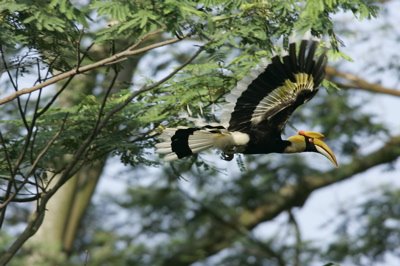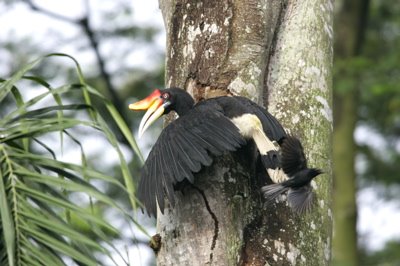The courtship behaviour of a Great (Buceros bicronis) and a Rhinoceros Hornbill (B. rhinoceros), both female, at Eng Neo has already been told. However, through the generosity of Meng and Melinda Chan, we are able to showcase here more of what actually happened around the old albizia tree (Paraserianthes falcataria).
The pair would meet in the morning and/or evening and the Great (above right, taking on the role of a male) would always check on the cavity. “He” would then fly back to join the Rhinoceros on a nearby branch and delicately fed the latter with a fig. This is the standard courtship ritual.
Possibly, this was to reassure her that “he” would keep on feeding her should she be sealed up in the cavity during egg incubation and after (should this happen). Only then would the Rhinoceros fly off to check the potential nest cavity. In the image below you can see a Greater Racket-tailed Drongo (Dicrurus paradisus) harassing the Rhinoceros. There was always a pair, probably breeding nearby, that followed the hornbills around.
The image on the left shows the Rhinoceros, with her head inside the cavity, checking the interior. The Great is perching on the tree trunk below, waiting for her decision.
The pair has been visiting the tree during February to May, as this is supposed to be the breeding period. There is a report of someone seeing the Rhinoceros entering the cavity, to move out soon after. But there has not been any attempt of the Rhinoceros sealing herself inside the cavity. This would be a distinct possibility, considering that both are females. And a female bird would only enter the cavity and seal herself in after copulation.
Such aberrant behaviour probably arises out of desperation. After all, there is only one of each bird in Singapore, both escapees. And they have come together out of loneliness.
Text by YC Wee, images by Meng and Melinda Chan.














11 Responses
YC, what nonsense are you spouting and encouraging here. All know that both are females. By continuing to extend irresponsibly the behaviour and daily routines of both hornbills, do u or r u seriously thinking that they will mate????
After copulation????? with what??
I am just stating a fact. That both the birds are females. Nothing more, nothing less. And why are you getting upset, anon?
Most male birds do not have a penis to insert into the female in order to transfer sperms. During copulation the cloaca of both birds are in contact for sperm transfer. So even if one of the hornbills is a male, there is no need of a “what” for copulation to take place.
I agree with anon. It depends what we want to dispense & propagate here. I am quite confident that many reading in this forum are NOT even aware that both are female birds, different species notwithstanding. I for one am not aware and was led to believe that we might have a case of cross-breeding here. I see where anon is coming from – that we should refrain from further “advertising” the behaviour of this pair with a pointedly insinuation that they will breed!
YC, do you mean “impossibility” in this line: “This would be a distinct possibility, considering that both are females”?
I don’t see any reason for the fuss raised by the anonymous trolls. The fact that the birds are female is stated clearly in the first sentence of the post. Anyone with sense would know that this means reproduction will never take place between the two birds. But that doesn’t preclude the possibility of them staging and going through all the rituals and acts of hornbill courtship and even ‘mating’.
Those who see the post as trying to dispense, propagate or advertise anything untoward are probably reading in the light of their own prejudices (and ignorance).
I would not go so far as to say that there is no possibility of the Rhino sealing hersefl in the cavity just because both are females. Anything can happen. However, for her to lay a fertile egg would not be possible.
My posting of the account is strictly scientific. I find it very interesting that (1) the pair is of different species; (2) that they are both females; and that (3) they are going through the typical hornbill courtship behaviour.
After all, homosexuality occurs among birds. The birds do mount each other. There have also been cases of attempted copulation.
Believe me, I am not trying to insinuate anything!
It surprise me that homosexuality do occur with birds too although I have see another documentary with birds of same species but different urm.. not sure what you call it.. type… mating. The difference was just in the colour.
Keep up the good work YC, I enjoyed this blog very much. As for the ‘insinuation’ part, no one can help those who choose to put 2 stamps on their eyes.
put me on your mailing list
Dear San
Either click “Subscribe-join” at the top of the page and enter your e-mail address or click “contact” or provide address.